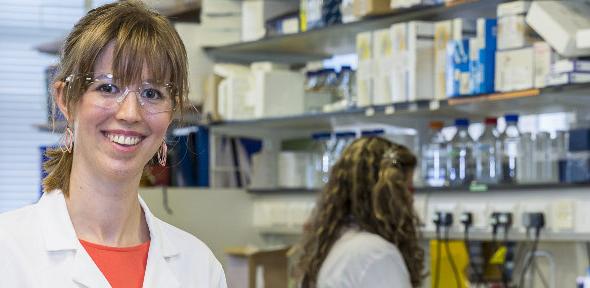
Dr Karen Stroobants is a postdoctoral researcher in the Centre for Misfolding Diseases. She researches membrane protein aggregates and their potential role in neurodegenerative diseases.
“The most rewarding thing for me as a scientist is discovering things,” says Dr Karen Stroobants. “There can be many days when your experiment does not work. But then there are a few days a year when an experiment suddenly works out well, or you discover something, and that balances out the frustration.”
Toy microscope
Karen’s interest in science started when she was a girl. At home in Belgium, she had a toy microscope and made an x-ray machine out of a cardboard box to scan her toys. When she started Chemistry lessons aged 14, one proved pivotal. “The day I learned about Marie Curie, I came home and told my mother I was going to become a chemist,” she says. It therefore means a great deal to her that, after receiving her undergraduate, Masters and PhD degrees from the University of Leuven, she secured a Marie Sklodowska-Curie Fellowship to fund her research in the Centre for Misfolding Diseases (CMD).
Karen’s research has always straddled the borders of chemistry and biochemistry. As part of her Masters she had spent a year in industry with Phillips Research in the Netherlands, “working on cardiovascular disease detection devices, where the goal was to take blood from a patient and inject it into a chip-like device that could determine the risk of cardiovascular diseases by detecting certain molecules in the blood,” she says. It was there she began using the biophysical techniques that have become a theme in her research. She built further on her experience of using them on her return to postgraduate research, this time characterising the interactions between proteins and inorganic complexes that were being developed as artificial enzymes. This experience proved helpful when, after her PhD, Karen’s curiosity turned to medical-related topics. When she discovered that the Centre for Misfolding Diseases uses biophysical techniques to study the protein aggregation important in Alzheimer’s and other diseases, it seemed an ideal match. After several visits, Karen started as a postdoc in the CMD in February 2015.
Misfolding proteins
Here she has been investigating the propensity of membrane proteins to misfold and self-assemble into amyloid fibrils, which are associated with a wide range of medical conditions such as Alzheimer’s and Parkinson’s diseases. Up to now, Karen explains, most studies have focused on cytosolic proteins, even though membrane proteins make up approximately 30 percent of the human proteome. But in a paper published in Biochemistry, Karen and her colleagues demonstrated that membrane proteins, like cytosolic proteins, can form amyloid-like fibrils under destabilizing conditions. “It generally is more difficult to study membrane proteins, which often require expression and purification procedures in lipid or detergent environments before they can be studied,” says Karen. But membrane proteins have a high propensity to aggregate because of their hydrophobic nature, which led Karen and her colleagues to suspect they might have an important role in diseases associated with protein misfolding.
Karen chose to study lactose permease (LacY) from Escherichia coli because it is an established protein that has been well characterized. The team used different biophysical techniques such as spectroscopy, X-ray fibre diffraction, circular dichroism spectroscopy and transmission electron microscopy to study the protein.The Biochemistry paper was well received. A subsequent viewpoint article described the work as setting the stage for future biophysical and biological studies of membrane protein aggregation, concluding: “This particular study is important, because transmembrane proteins make up such a large percentage of the human proteome.”
Karen has been influenced by several role models. They include Professor Dame Athene Donald, the Master of Churchill College where Karen is a Postdoctoral By-Fellow. “She is not only a brilliant physicist but also has a profound interest in science policy." Karen also admires Professor Dame Carol Robinson, who became the first female Professor in Chemistry both in Cambridge and Oxford, after taking an eight-year career break to take care of her children. But above all, there is Marie Curie. “I have been intrigued by her life path and accomplishments from the first time I heard about her, and she remains my most important role model.”
Beyond the bench
Outside the lab, Karen is current president of the Cambridge University Science and Policy Exchange (CUSPE), an organisation run by early career researchers that aims to provide insight into the process of policy design, raise awareness of the communications difficulty commonly experienced during science-policy exchanges and build stronger links between its members and policy-makers. Karen, who has a strong interest in science policy, believes in the importance of good communications between academia, industry, policy makers and society. She devotes time to CUSPE and other activities, including the policy work group of the Marie Curie Alumni Association, hoping that “these efforts might be valuable and contribute to restoring the importance of evidence-informed policy in a world currently ruled by ‘alternative facts’.”
“I’m thinking about going into policy,” she adds. “It’s something I love as much as chemistry.” What does Karen think the future will bring her? She says: “With the right balance between science and policy initiatives, I’m keeping my options open for now. The future will tell.”

